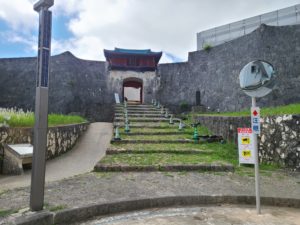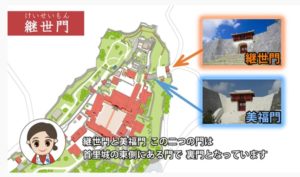Martial arts demonstration in front of the king at Shuri Castle
While there are some anecdotes about Ryūkyū Kings and karate, like the ones relating to Matsumura Sōkon, martial arts related events mentioning specific areas of Shuri Castle are rare.
In 1866 was held the Sakuho ceremony of the last king of the Ryūkyū, Shō Tai. The following year, as the ceremony was completed successfully, a celebration was held at Uchaya Udun. Following the event, a karate and kobujutsu performance was held in front of the king in front of “Akata Ujō” gate.
(This event was introduced by curator Mrs. Sakihara Kyōko during a 2019 karate-related historic site tour. She also pinpointed that based on prewar records on Shuri Castle, the “Akata Ujō” gate originally referred to the “Bifukumon” gate and later the “Keiseimon” gate.)

To support this historical fact, the records “Tāfākū” of Kumemura – Kume Village mentions the program “Sanruchu Narabi Shogei Bangumi” which included martial arts demonstrations performed at the Uchaya Udun palace in Sakiyama in March 1867 and the later demonstration in front of the king.
Reference: “After proceeding according to the various programs and finishing by 7 o’clock, flagpoles were raised and a tug-of-war procession was formed in Kumemura in order to welcome the Sanruchu performers. Reaching Sakiyama Baba, the performers fully dressed joined in the procession to really create a Kumemura on parade. On the way back, they approached Akata Ujō where the king had hanged a script on the gate and was resting. Through the king’s envoy, the performers were asked to once again demonstrate their martial skills. As told, they performed 5 demonstrations in the street in front of the gate for the lord’s leisure. They then went back to Kumemura living from Tennōji, passing through the town and exiting from Shimo Ayajō (1).” (“Collection of writings of Shimabukuro Zenpatsu”, published in 1956.)

Keiseimon (upper photo in orange) and Bifukumon (lower image in blue)
These two gates are located on the east side of Shuri castle and are considered back gates.
(Source: Shuri Castle Guided Tour 12th episode “Keiseimon and Bifukumon” https://www.youtube.com/watch?v=3lHcdPHnm8I)
(1) Tennōji was a Rinzai sect temple during the Ryūkyū Kingdom era where the Shō queen was later enshrined. The site of the temple is located close to where the Shuri Church stands today, not far from Shuri Tonokura Post Office.
During the Ryūkyū Kingdom era, the road from Naha Port, the gateway to the sea, to Shuri Castle via Sogenji Temple in Tomari was the most famous public road in the kingdom. In particular, the wide road centered between “Shimo Ayajō” (another name for Chuzanmon gate– approximately where stand the store Shuri Ryusen next to Shuri Senior High School) and “Ui no Ayajō” (another name for Shureimon gate) was called “Ayajō Ufumichi”.
(Source: Naha City Museum of History, translation by OKIC)
